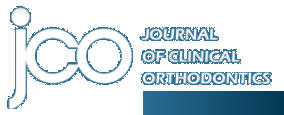Search Results For: 'case report'
421.
The Straight-Wire Appliance: Case Histories: Non-Extraction
Volume 10 : Number 4 : Page 282 : Apr 1976
JCO does not have the copyright to this article. For more information on the article, please contact The Andrews Foundation at lfAndrews@aol.com or go to their website at https://www.andrewsfoundation...
422.
BOOK REVIEWS
Practical Early Orthodontic Treatment: A Case-Based Review
Volume 57 : Number 8 : Page 468 : Aug 2023
THOMAS E. SOUTHARD, DDS, MSSTEVEN D. MARSHALL, DDS, MSLAURA L. BONNER, DDS, MSKYUNGSUP SHIN, PHD, DMD, MS 848 pages, 2,728 illustrations. $249.99. 2022.Wiley Blackwell, 1 Wiley Drive, Somerset, NJ 08...
423.
BOOK REVIEWS
Volume 50 : Number 3 : Page 0 : Mar 2016
The best way to learn orthodontics outside of clinical experience is to critically review case reports. Case-based review is the foundation of orthodontic residency education, and it is precisely the method used in this book by Drs. Thomas Southard, Steven Marshall, and Laura Bonner. In an interesting twist, these renowned clinicians and educators have written their text entirely in a question-and-answer format. The reader immediately becomes part of the academic discussion as the authors ask question after question aimed at providing resolution of the presented cases.
424.
PEARLS
Volume 39 : Number 5 : Page 322 : May 2005
To ensure that every aspect of a case has been finished to our quality standards, our department has developed a checklist that we begin to fill out three to six months before debonding each patient. ...
425.
LETTERS
Volume 30 : Number 10 : Page 0 : Oct 1996
I was very interested to read the recent Case Report, "Treatment of Adult Midline Deviation by Condylar Repositioning", by Dr. Fred Schudy (JCO, June 1996). I feel compelled to respond for a number of...
426.
TECHNIQUE CLINIC
Correction of Single-Tooth Anterior Crossbite
Volume 31 : Number 3 : Page 188 : Mar 1997
Removable appliances with finger springs have traditionally been used to treat dental anterior crossbites in the early mixed dentition. The major drawback of this method is that it requires patient co...
427.
THE EDITOR'S CORNER
Volume 56 : Number 8 : Page 446 : Aug 2022
As the new Editor-in-Chief, I am frequently asked about my vision for JCO moving forward. Perhaps the most notable change with regard to content will be an increase in case reports and technique artic...
428.
DIAGNOSTIC CHALLENGE
Volume 59 : Number 1 : Page 61 : Jan 2025
In this monthly column, Contributing Editors Gayle Glenn, DDS, MSD, and Shawn L. Miller, DMD, MMSc, present a case to challenge your diagnosis and treatment-planning skills. Review the initial records...
429.
THE READERS' CORNER
Occlusal Curves and Case Presentations
Volume 37 : Number 4 : Page 197 : Apr 2003
We generally flatten the curve of Spee. Does a flat curve of Spee afford good functioning occlusion? Eighty-three percent of the respondents believed that flattening the curve of Spee provided a good ...
430.
The Possibility of Skeletal Anchorage
Volume 4 : Number 4 : Page 266 : Apr 1983
Toothborne anchorage is one of the greatest limitations of modern orthodontic treatment, because teeth move in response to forces. While extraoral anchorage can be used to supplement toothborne anchor...
431.
Volume 6 : Number 1 : Page 41 : Jan 1972
41-jco-img-0.jpgA reverse headgear is an extraoral device used to move teeth or bony segments forward. It is capable of closing large spaces by moving posterior teeth forward. It has also been success...
432.
Distalization with 'Driftodontics'
Volume 28 : Number 7 : Page 0 : Jul 1994
Crowding in the permanent dentition is usually treated by extraction, interproximal reduction lateral expansion, or extraoral traction.1 Molar distalization can be achieved with headgear in the upper ...
433.
Volume 18 : Number 10 : Page 738 : Oct 1984
In patients who have maxillary arch problems but a well-aligned lower arch, correction may be amenable to a nonextraction approach if the skeletal relationship is not too severe and growth prospects a...
434.
Volume 28 : Number 4 : Page 0 : Apr 1994
Bonding orthodontic attachments can be problematic in adult patients with crown-and-bridge restorations.1 Ceramic or veneer crowns must be roughened or etched before bonding,2,3 and debonding leaves a...
435.
DIAGNOSTIC CHALLENGE
Volume 59 : Number 2 : Page 135 : Feb 2025
In this monthly column, Contributing Editors Gayle Glenn, DDS, MSD, and Shawn L. Miller, DMD, MMSc, present a case to challenge your diagnosis and treatment-planning skills. Review the initial records...
436.
DIAGNOSTIC CHALLENGE
Volume 59 : Number 3 : Page 177 : Mar 2025
In this monthly column, Contributing Editors Gayle Glenn, DDS, MSD, and Shawn L. Miller, DMD, MMSc, present a case to challenge your diagnosis and treatment-planning skills. Review the initial records...
437.
DIAGNOSTIC CHALLENGE
Volume 59 : Number 4 : Page 251 : Apr 2025
In this monthly column, Contributing Editors Gayle Glenn, DDS, MSD, and Shawn L. Miller, DMD, MMSc, present a case to challenge your diagnosis and treatment-planning skills. Review the initial records...
438.
DIAGNOSTIC CHALLENGE
Volume 59 : Number 5 : Page 323 : May 2025
In this monthly column, Contributing Editors Gayle Glenn, DDS, MSD, and Shawn L. Miller, DMD, MMSc, present a case to challenge your diagnosis and treatment-planning skills. Review the initial records...
439.
DIAGNOSTIC CHALLENGE
Volume 59 : Number 6 : Page 406 : Jun 2025
In this monthly column, Contributing Editors Gayle Glenn, DDS, MSD, and Shawn L. Miller, DMD, MMSc, present a case to challenge your diagnosis and treatment-planning skills. Review the initial records...
440.
BOOK REVIEWS
Volume 48 : Number 7 : Page 444 : Jul 2014
DAN COUNIHAN, BDS, FDS, FFD, MOrth 414 pages. $153. 2014.Self-published; available from www.orthodonticsfortheface.com. I enjoy reading orthodontic journals from back to front, starting with the clini...
Showing 421-440 of 3208 results. Search completed in 0.121 seconds.

